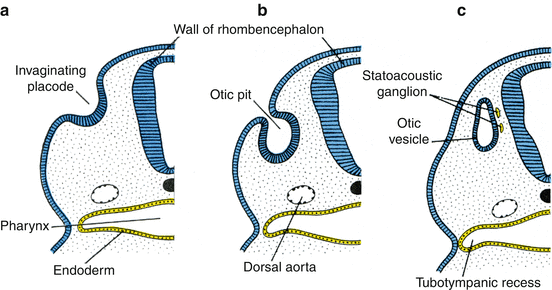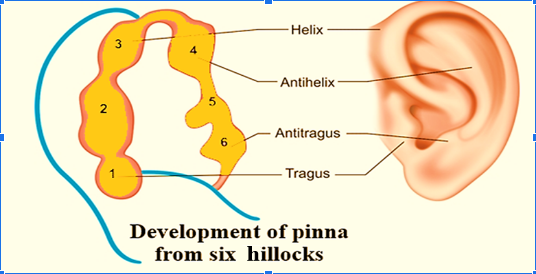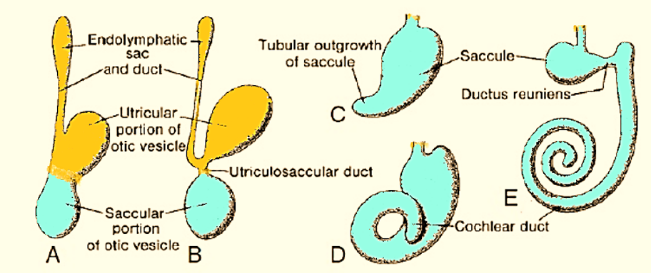
EMBRYOLOGY OF EAR
Embryology is the study of the origin and development of single individual embryo in prenatal period.
Development of different parts of the ear
Outer ear development
Acute mastoiditis is a complication of acute suppurative otitis media, where the infection spreads from the mucosal lining of the antrum to involve the bony walls of the mastoid air system.
- Pinna arises from fusion of six auricular hillocks.
- By the end of 4th week, the auricle develops from 6 mesenchymal proliferations (hillocks) of 1st and 2nd pharyngeal arches, surrounding the first pharyngeal cleft.
- These auricular hillocks, three on each side of the external meatus, later fuse and form the definitive auricle.

- External auditory meatus develops from ectoderm of first pharyngeal cleft.
- At the 3rd month, epithelial cells at the bottom of the meatus proliferate, forming a solid epithelial plate, the meatal plug.
- In the 7th month, this plug dissolves and the epithelial lining of the floor of the meatus participates in formation of the definitive eardrum.
- TM has three layers. Inner layer “endoderm”, Middle layer “mesoderm” and Outer layer “ectoderm”.
Middle ear development
- The middle ear cavity and the auditory tube arise from first pharyngeal pouch called the tubotympanic sulcus, lined by endoderm.
- This pouch expands in a lateral direction and comes in contact with the floor of the first pharyngeal cleft.
- The distal part forms the tubotympanic recess.
- The proximal part forms the auditory tube (Eustachian tube).
- The ossicles of the middle ear:
- By the end of 7th week, the mesenchyme above the primitive tympanic cavity shows a number of condensations caused by proliferation of the dorsal tips of pharyngeal arches I and II.
- The condensations become the cartilaginous precursors of the auditory ossicles, the malleus, the incus, and the stapes.
- The malleus and incus are derived from pharyngeal arch I (Meckel’s cartilage) and the stapes is derived from arch II (Reichert’s cartilage).
- The ossicles appear during the first half of fetal life but remain embedded in mesenchyme until 8th month.
- During the 8th and 9th months, programmed cell death and other resorptive processes clear the middle ear cavity and leave the auditory ossicles suspended within it.
- During late fetal life, the tympanic cavity expands dorsally by vacuolization of surrounding tissue to form the tympanic antrum. The tympanic cavity becomes almost twice as large as originally.
- After birth, epithelium of the tympanic cavity invades bone of the developing mastoid process. Later, most of the mastoid air sacs come in contact with the antrum and tympanic cavity.
- When the ossicles are entirely free from the surrounding mesenchyme, the entodermal epithelium connects them in a mesentery in the form of supporting ligaments of the ossicles.
- Free movement of the auditory ossicles is acquired within 2 months after birth.
- Since the malleus is derived from pharyngeal arch I, its muscle, the tensor tympani, is innervated by the mandibular branch of the trigeminal (V) nerve.
- Since the stapes is of pharyngeal arch II, its muscle, the stapedius, is innervated by the facial (VII) nerve.
- Later, the endodermal epithelium of the tubotympanic sulcus becomes close to the ectoderm lining the first pharyngeal cleft, separated by mesoderm. This complex forms the tympanic membrane (eardrum). During fetal life, a prominent ring-shaped structure, called the tympanic ring, supports the tympanic membrane. Later, the tympanic ring becomes absorbed into the temporal bone.
- The part of the osseous labyrinth opposite the stapes remains thin and becomes the oval window (fenestra vestibuli) which opens into the vestibule. Below this, another thinning of the bony labyrinth forms the round window (fenestra cochleae) which opens into the scala tympani. Both are closed by membranes.

Inner ear and the formation of the membranous labyrinth
- Membranous labyrinth: Derived from ectodermal invagination from otic placode.
- Bony labyrinth: Arises from mesoderm.
- In the 6th week of development: saccular lower pole forms the cochlear duct which penetrates surrounding mesenchyme in a spiral fashion and complete 2.5 turns at the end of the 8th week. The ductus reuniens connects the saccule with utricle.
- Mesenchyme surrounding the cochlear duct forms cartilage.
- In the 10th week, this cartilaginous shell undergoes vacuolization, and two perilymphatic spaces, the scala vestibuli and scala tympani develops.
- The vestibular membrane separates cochlear duct from the scala vestibuli.
- The basilar membrane separates cochlear duct from the scala tympani.
- The spiral ligament attaches lateral wall of the cochlear duct to the surrounding cartilage.
- The median angle of the cochlear duct is connected and partly supported by a long cartilaginous process, the modiolus, which is the future axis of the bony cochlea.
- The epithelial cells of the cochlear duct form two ridges:
- The inner ridge- forms the future spiral limbus.
- The outer ridge which forms the sensory hair cells a) One inner row b) Three or four outer rows.
- They are covered by the tectorial membrane.
- The sensory cells + tectorial membrane constitute the Organ of Corti.
- Impulses received by the organ of Corti goes via the spiral ganglion to the nervous system by the auditory fibers of 8th cranial nerve.
- The capsular cartilage serves as a template for formation of the true bony labyrinth. The conversion from the cartilaginous to the bony labyrinth occurs between 16 and 23 weeks of gestation.

Utricle and Semicircular canals
- During the 6th week of development, semicircular canals appear as flattened out-pocketings of the utricular part of the otic vesicle. Central portions of the walls of them appose each other and disappear (programmed cell death), giving rise to three semicircular canals.
- One end of each canal dilates forming the crus ampullare and the other end the crus non-ampullare does not widen.
- Five crura enter the utricle, three having ampulla and two without ampulla.
- Cells in the ampullae form a crest called the crista ampullaris, containing sensory cells.
- Similar sensory areas develop in the walls of the utricle and saccule.
- Impulses generated in sensory cells of the cristae and maculae as a result of a change in body position and reaches the brain by vestibular fibers of VIII cranial nerve.
- The statoacoustic ganglion forms during formation of the otic vesicle and the ganglion splits into cochlear and vestibular portions.
Endolymphatic Duct and Sac
- The auditory vesicle elongates and develops an indenting groove, which demarcates a tubular diverticulum on its medial side which will be modified into the endolymphatic sac and duct, and continues to grow postnatally until the age of three or four years of life.
We Are Always Ready to Help You.
Book An Appointment

